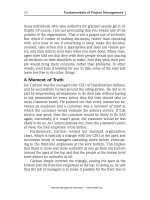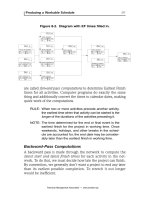Exploring management 6th by schermerhornch02
Bạn đang xem bản rút gọn của tài liệu. Xem và tải ngay bản đầy đủ của tài liệu tại đây (495.51 KB, 46 trang )
Exploring
Management
John R. Schermerhorn, Jr. and Daniel G. Bachrach
Sixth Edition
Chapter 2
Management Learning
Great Things Grow from Strong Foundations
Great Things Grow From Strong Foundations
Great management isn’t new,
and it isn’t all high tech . . . it is
part of our history.
Copyright ©2018 John Wiley & Sons, Inc.
2
Your Chapter 2 Takeaways
• Understand lessons from classical management
approaches (2.1)
• Identify insights from behavioral management
approaches. (2.2)
• Recognize foundations of modern management
thinking. (2.3)
Copyright ©2018 John Wiley & Sons, Inc.
3
CLASSICAL MANAGEMENT APPROACHES 2.1
Takeaway 2.1 – answers to come
• Taylor’s scientific management sought efficiency in
job performance.
• Weber’s bureaucratic organization is supposed to be
efficient and fair.
• Fayol’s administrative principles describe managerial
duties and practices.
Copyright ©2018 John Wiley & Sons, Inc.
4
CLASSICAL MANAGEMENT APPROACHES 2.1
Classical Management Approaches
• Scientific management – practical insights:
• Make results-based compensation a performance
incentive
• Carefully design jobs with efficient work methods
• Carefully select workers with the abilities to do these
jobs
• Train workers to perform jobs to the best of their
abilities
• Train supervisors to support workers so they can
perform jobs to the best of their abilities
Copyright ©2018 John Wiley & Sons, Inc.
5
Classical Management Approaches
Copyright ©2018 John Wiley & Sons, Inc.
6
CLASSICAL MANAGEMENT APPROACHES 2.1
Taylor’s Scientific Management
Four core principles of scientific management (Frederick
Taylor):
1. Develop a “science” for each job -- rules of motion,
standard work tools, and proper work conditions.
2. Hire workers with the right abilities for the job.
3. Train and motivate workers to do their jobs according
to the science.
4. Support workers by planning and assisting their work
according to the science.
Copyright ©2018 John Wiley & Sons, Inc.
7
CLASSICAL MANAGEMENT APPROACHES 2.1
Taylor’s Scientific Management
• Scientific management (the Gilbreths)
• Motion study
• Science of reducing a job or task to its basic
physical motions
• Eliminating wasted motions improves performance
• Taylor hoped to improve the productivity of workers
and organizations.
• With a stopwatch and notebook, Taylor analyzed
tasks and motions to determine the most efficient
way to perform them.
Copyright ©2018 John Wiley & Sons, Inc.
8
CLASSICAL MANAGEMENT APPROACHES 2.1
Weber’s Bureaucratic Organization
• Bureaucratic organization (Max Weber)
• Bureaucracy is a specific approach at the heart of Weber’s
proposal for correcting performance problems with
organizations
• An ideal, intentionally rational, and very efficient form of
organization
• Based on principles of logic, order, and legitimate
authority
• People are selected for jobs based on their competency
and demonstrated performance
Copyright ©2018 John Wiley & Sons, Inc.
9
CLASSICAL MANAGEMENT APPROACHES 2.1
Characteristics of an Ideal Bureaucracy
Characteristics of an Ideal Bureaucracy
Clear Division of Labor—Jobs are well defined, and workers become highly
skilled at performing them.
Clear Hierarchy of Authority—Authority and responsibility are well defined, and
each position reports to a higher-level one.
Formal Rules and Procedures—Written guidelines describe expected behavior
and decisions in jobs, and written files are kept for the historical record.
Impersonality—Rules and procedures are impartially and uniformly applied, so
no one gets preferential treatment.
Careers Based on Merit—Workers are selected and promoted on ability and
performance, and managers are career employees of the organization.
Copyright ©2018 John Wiley & Sons, Inc.
10
CLASSICAL MANAGEMENT APPROACHES 2.1
Bureaucratic Organization
Possible disadvantages of bureaucracy:
• Excessive paperwork or “red tape”
• Slowness in handling problems
• Rigidity in the face of shifting needs
• Resistance to change
• Employee apathy
Copyright ©2018 John Wiley & Sons, Inc.
11
CLASSICAL MANAGEMENT APPROACHES 2.1
Fayol’s Administrative Principles
• An attempt to document and understand the
experiences of successful managers.
• Scalar chain principle
• there should be a clear and unbroken line of
communication from the top to the bottom of the
organization
• Unity of command principle
• each person should receive orders from only one
boss
Copyright ©2018 John Wiley & Sons, Inc.
12
CLASSICAL MANAGEMENT APPROACHES 2.1
Fayol’s Administrative Principles
Five “Rules” or “Duties” of Management
Foresight—complete a plan of action for the future.
Organization—provide and mobilize resources to implement plan.
Command—lead, select, and evaluate workers.
Coordination—fit diverse efforts together, ensure information is
shared and problems are solved
Control—make sure things happen according to plan, take
necessary corrective action.
Copyright ©2018 John Wiley & Sons, Inc.
13
CLASSICAL MANAGEMENT APPROACHES 2.1
Study Guide for Takeaway 2.1
Rapid Review
• Taylor’s principles of scientific management focused on the need
to carefully select, train, support, and reward workers in their
jobs.
• Weber considered bureaucracy, with its clear hierarchy, formal
rules, well-defined jobs, and competency-based staffing, to be a
form of organization that is efficient and fair.
• Fayol suggested that managers learn and fulfill duties we now
call the management functions of planning, organizing, leading,
and controlling.
Copyright ©2018 John Wiley & Sons, Inc.
14
CLASSICAL MANAGEMENT APPROACHES 2.1
Study Guide for Takeaway 2.1
Questions for Discussion:
1. How did Taylor and Weber differ in the approaches
they took to improving the performance of
organizations?
2. Should Weber’s concept of the bureaucratic
organization be scrapped, or does it still have
potential value today?
3. What are the risks of accepting the “lessons of
experience” offered by successful executives such as
Fayol?
Copyright ©2018 John Wiley & Sons, Inc.
15
CLASSICAL MANAGEMENT APPROACHES 2.1
Be Sure You Can... For Takeaway 2.1
•
list the principles of Taylor’s scientific management
•
list key characteristics of bureaucracy
•
explain why Weber considered bureaucracy an ideal
form of organization
•
list possible disadvantages of bureaucracy
•
describe how Fayol’s “duties” overlap with the four
functions of management
Copyright ©2018 John Wiley & Sons, Inc.
16
CONTRIBUTIONS OF BEHAVIORAL MANAGEMENT APPROACHES 2.2
Takeaway 2.2 – Answers to Come
• Follett viewed organizations as communities of
cooperative action.
• The Hawthorne studies focused attention on the
human side of organizations.
• Maslow described a hierarchy of human needs with
self-actualization at the top.
• McGregor believed managerial assumptions create
self-fulfilling prophecies.
• Argyris suggests that workers treated as adults will be
more productive.Copyright ©2018 John Wiley & Sons, Inc.
17
CONTRIBUTIONS OF BEHAVIORAL MANAGEMENT APPROACHES 2.2
Follett’s Organizations as Communities
• Mary Parker Follett – Visionary Leadership
• Warned against the dangers of too much hierarchy
• Advocated social responsibility, respect for workers,
and better cooperation throughout organizations
• Follett suggested making every employee an owner
in the business to create collective responsibility
• Today, this results in “empowerment,”
“involvement,” “flexibility,” “self-management,” and
“transformational leadership.”
Copyright ©2018 John Wiley & Sons, Inc.
18
CONTRIBUTIONS OF BEHAVIORAL MANAGEMENT APPROACHES 2.2
Follett’s Organizations as Communities
Figure 2.1 Who Are the Major Contributors to the Behavioral or Human
Resource Approaches to Management Thinking?
Copyright ©2018 John Wiley & Sons, Inc.
19
CONTRIBUTIONS OF BEHAVIORAL MANAGEMENT APPROACHES 2.2
Follett’s Organizations as Communities
Forward-looking management insights
Making every employee an
owner creates a sense of
collective responsibility
Precursor of employee
ownership, profit sharing, and
gain sharing
Business problems involve a
variety of inter-related factors
Precursor of systems thinking
Private profits relative to
public good
Precursor of managerial
ethics and social responsibility
Copyright ©2018 John Wiley & Sons, Inc.
20
CONTRIBUTIONS OF BEHAVIORAL MANAGEMENT APPROACHES 2.2
The Hawthorne Studies
• Hawthorne studies
• Focused attention on the human side of
organizations
• Initial study examined how economic incentives and
physical conditions affected worker output
• No consistent relationship found
• “Psychological factors” influenced results
Copyright ©2018 John Wiley & Sons, Inc.
21
CONTRIBUTIONS OF BEHAVIORAL MANAGEMENT APPROACHES 2.2
The Hawthorne Studies (cont.)
• Social setting and human relations
• Manipulated physical work conditions to assess
impact on output
• Designed to minimize the “psychological factors” of
previous experiment
• Mayo and colleagues concluded:
• New “social setting” led workers to do good job
• Good “human relations” = higher productivity
• Employee attitudes and group processes
• Some things satisfied some workers but not others
• People restricted
output to adhere to group norms
Copyright ©2018 John Wiley & Sons, Inc.
22
CONTRIBUTIONS OF BEHAVIORAL MANAGEMENT APPROACHES 2.2
Lessons from the Hawthorne Studies
• Social and human concerns are keys to productivity
• Hawthorne effect — people who are singled out for
special attention perform as expected
Copyright ©2018 John Wiley & Sons, Inc.
23
CONTRIBUTIONS OF BEHAVIORAL MANAGEMENT APPROACHES 2.2
Maslow’s Hierarchy of Human Needs
• Maslow’s hierarchy of human needs
• A need is a physiological or psychological deficiency
a person feels compelled to satisfy
• Need levels:
•
•
•
•
•
Physiological
Safety
Social
Esteem
Self-actualization
Copyright ©2018 John Wiley & Sons, Inc.
24
CONTRIBUTIONS OF BEHAVIORAL MANAGEMENT APPROACHES 2.2
Maslow’s Hierarchy of Human Needs
Figure 2.2 How Does Maslow’s
Hierarchy of Needs Operate?
Copyright ©2018 John Wiley & Sons, Inc.
25









